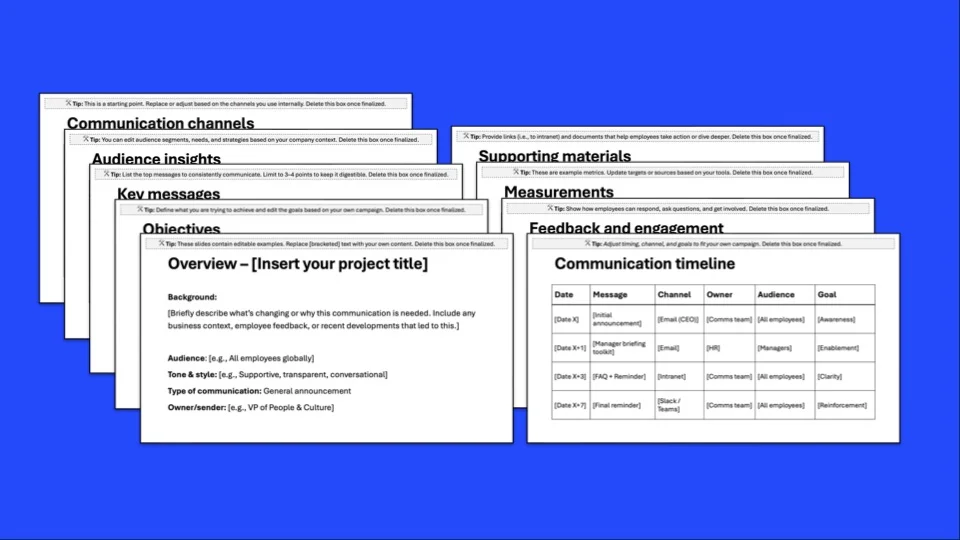An internal communications plan will fail if it’s too vague, overly complex, or disconnected from real employee needs. The result? Misalignment, disengagement, and frustration.
A well-structured internal communications plan ensures that the right messages reach the right people at the right time. It keeps employees informed, leadership transparent, and teams aligned—making it a non-negotiable for any organization that values efficiency and engagement.
What is an internal communications plan?
An internal communications plan is a structured strategy for how information flows within a company. It defines who communicates what, how, and when to ensure clarity, transparency, and engagement.
Who it’s for: HR teams, communications professionals, leadership, and employees—anyone responsible for keeping the organization connected.
How it differs from corporate communications: While corporate comms focus on external messaging, an internal communications plan ensures that employees receive the information they need to work efficiently and feel engaged.
Step-by-step guide to creating an effective internal communications plan
1. Define your communication goals
What do you want to achieve? Higher engagement? Faster decision-making? Improved leadership transparency?
Tie goals to business outcomes. Example: If engagement is low, set a goal to improve survey participation by 20%.
2. Identify your audience
Not all employees need the same type of information. Segment your audience.
Leadership: Strategy and high-level updated.
People leaders: Actionable insights for their teams.
Frontline employees: Practical, day-to-day information.
3. Choose the right channels & tools
Use the right platform for the message.
Quick updates? Slack, Microsoft Teams
Company-wide announcements? Email, Intranet, Town halls
Leadership Q&As? Ask Me Anything sessions, video messages
Balance synchronous (real-time) and asynchronous (on-demand) communication to avoid overload.
Find out the best internal communication platforms to keep your teams aligned.
4. Craft a clear messaging framework
Keep messages concise, jargon-free, and actionable.
Example: Apple maintains crisp, to-the-point internal messaging that keeps employees focused.
5. Establish feedback loops
Internal communication isn’t a one-way street — employees need a voice. Gather real feedback through:
Pulse surveys (short, frequent check-ins)
Online polls (quick feedback in real-time)
1:1 conversations (deeper insights from employees).
6. Measure and improve
Track internal communication Key Performance Indicators (KPIs)to improve where needed:
Feedback response times (Are concerns addressed quickly?)
Email open rates (Are messages being read?)
Engagement scores (Are employees interacting?)
Case studies: real companies that got it right (and wrong)
Success story | Blackstone
Challenge: Blackstone sought to enhance employee engagement and align interests between workers and investors within its portfolio companies.
Approach: In May 2023, Blackstone implemented an employee-ownership program at Copeland, an HVAC company it acquired. This initiative granted stock to 18,000 Copeland employees across 43 countries, accompanied by comprehensive communication efforts, including video briefings in eight languages to ensure all employees understood the equity model.
Outcome: Following the program’s launch, employee engagement surged, demonstrating early success in fostering a more invested workforce.

Failure story | X (Formerly know as Twitter)
Challenge: After Elon Musk’s acquisition of Twitter (know known as ‘X’), an email was sent asking employees to commit to an “extremely hardcore” work schedule or resign. The lack of clarity and personal engagement led to confusion.
Approach: The company assumed non-responses as resignations without direct confirmation, leading to disputes.
Outcome: This approach resulted in legal challenges, including a case where an employee was awarded approximately $600,000 for unfair dismissal, highlighting the consequences of poor internal communication.

Common internal communications plan mistakes (and how to avoid them)
| Common mistakes | How to avoid |
|---|---|
| ✘ Overloading employees with too much information | ✔ Prioritize and streamline messaging |
| ✘ Focusing only on top-down communication | ✔ Make feedback a priority |
| ✘ Using the wrong channels for the wrong messages | ✔ Match communication methods to employee needs. |
Final thoughts
An effective internal communications plan ensures that employees stay informed, engaged, and aligned with business goals.
The next step? Choosing the right tools to implement your strategy. Check out our guide to the best internal communication platforms to find out what’s worth your time.







